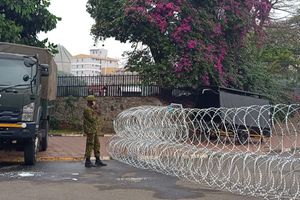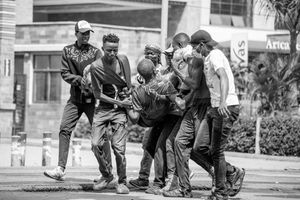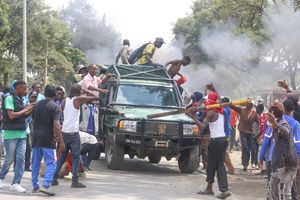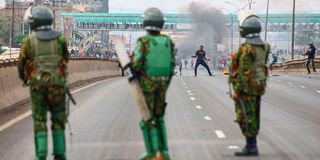
Anti-riot police officers keep an eye on demonstrators during Saba Saba protests at Roysambu roundabout on Thika Road in Nairobi on July 7, 2025.
With Nairobi’s central business district under lockdown on Monday, protests to mark Saba Saba spilled into the city’s environs and estates.
From Roysambu to Kangemi, Kitengela, Rongai, Juja, Ruiru and Githurai, demonstrators lit bonfires, blocked roads and engaged police in clashes that stretched well into the evening.
The CBD itself bore an eerie stillness after roadblocks were set up on key roads. Open-source app, vercel.app, showed that at least 25 roadblocks had been mounted, with both pedestrians and motorists turned back.
In Roysambu, hundreds of youth poured onto Kamiti Road chanting anti-government slogans and waving placards that echoed national frustrations over punitive taxation, police brutality and the high cost of living.
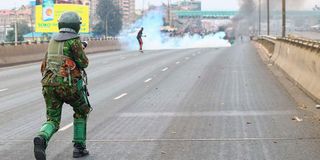
An anti-riot police officer repels a protester during Saba Saba protests at Roysambu roundabout on Thika Road in Nairobi on July 7, 2025.
Protesters used stones, old tyres and debris to block roads.
“We are tired,” said one young man, his face wrapped in a torn T-shirt to protect himself from the tear gas. “They blocked town thinking we would be silent but we will shout from here.”
Police responded with force to disperse the growing crowd, but the protesters retreated into nearby residential compounds, only to re-emerge from another direction.
Similar scenes played out in Kitengela, a satellite town on Nairobi’s southeastern fringe. Protesters there blocked Namanga Road, bringing traffic to a standstill.
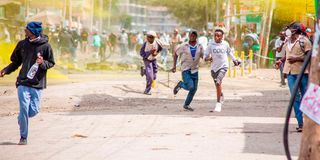
Protesters scamper for safety from a police water cannon truck during Saba Saba protests in Kitengela on July 7, 2025.
In Ongata Rongai, crowds marched down Magadi Road forcing matatus to turn back. Shops and petrol stations quickly pulled down their shutters as tension rose.
Intense confrontations
Protesters held aloft makeshift placards with anti-government messages. They chanted slogans calling for justice for those killed in earlier protests.
In Kangemi on the western edge of the city, there were intense confrontations. Young people took over sections of Waiyaki Way, lighting fires and pelting police vehicles with stones. At least one protester was shot and left lying on the road.
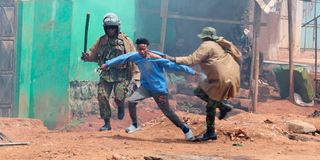
A protester is cornered by anti-riot police officers during Saba Saba protests in Kangemi, Nairobi on July 7, 2025.
“They are angry because they feel there is no future,” said a resident, watching from a safe distance. “And now, instead of listening, the government is sending police.”
Juja, a university town along Thika Road, also witnessed protests. Demonstrators blocked sections of the busy highway, lit fires on the road and chanted slogans denouncing State oppression and economic mismanagement. Tear gas canisters rained down near hostels and local businesses, forcing residents to stay indoors.
Protesters used social media and encrypted messaging platforms to coordinate movements, warn of police presence, and share real-time updates.
Saba Saba commemorates the 1990 riots that catalysed the push for multiparty democracy. Many of this year’s protesters drew parallels between the struggles of the past and today’s discontent.
“This is our generation’s Saba Saba,” said a university student in Rongai. “They fought for political freedom. We are fighting for economic justice.”
Additional reporting by Simon Ciuri, Stanley Ngotho and Leon Lidigu


